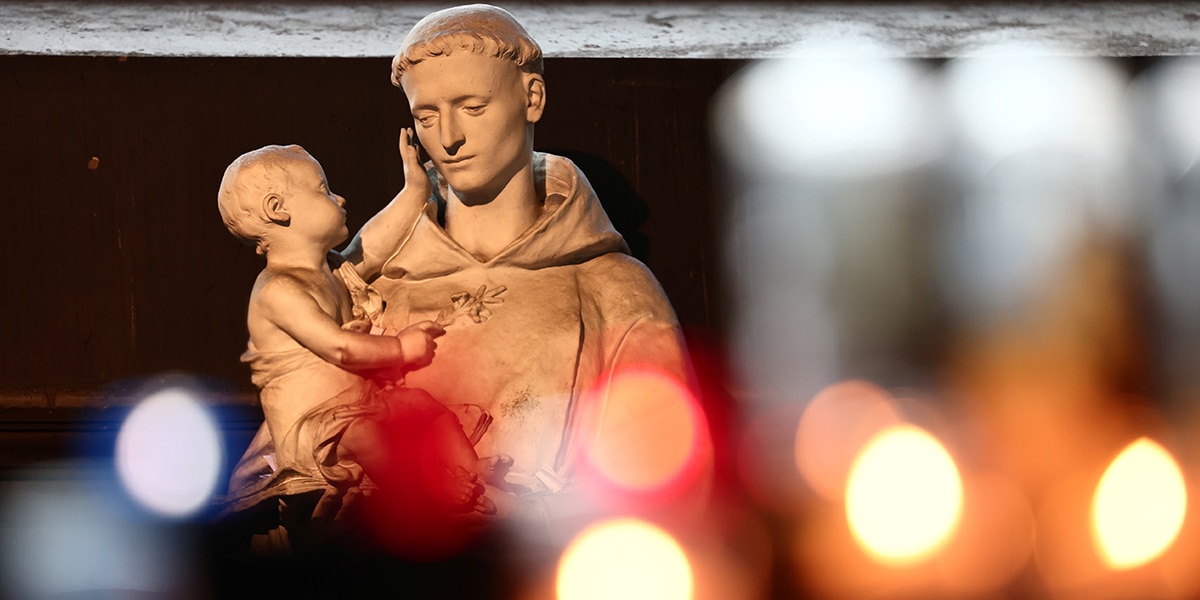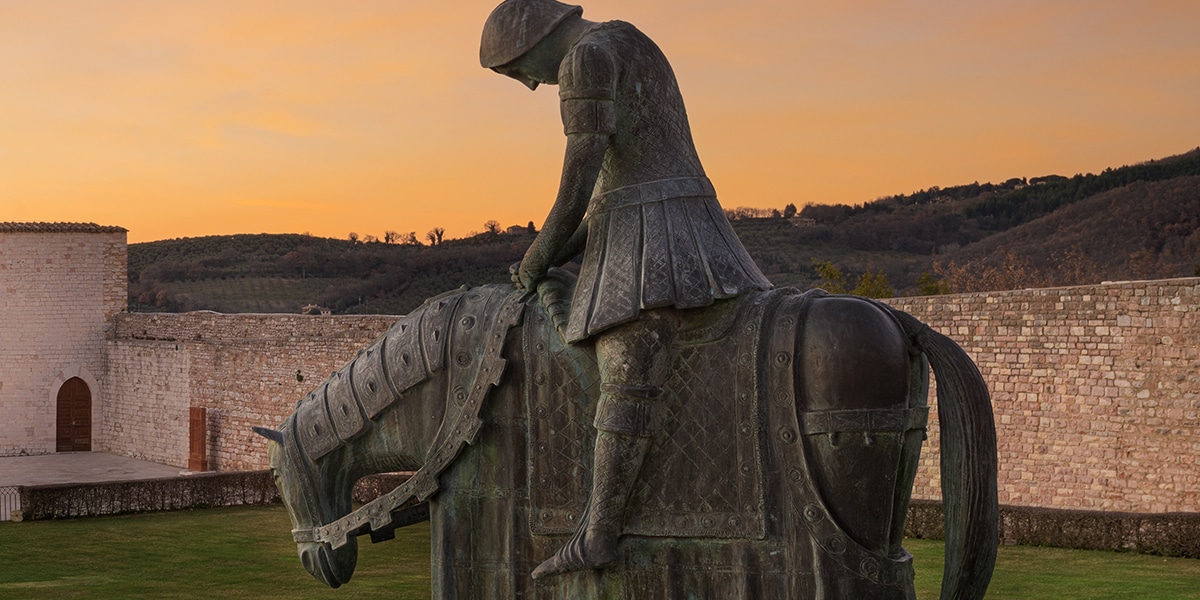In this month of celebration, it’s difficult to believe that Anthony ever left the city of his birth. He surely can be found there now.
Santo Antoninho: Little St. Anthony is the pet name of the great St. Anthony in Portugal. Rightly so!
When Anthony was little, Lisbon was home to him. He belongs to Portugal in his birth, in his education, in his entry into religious life and in his introduction to the Franciscans. Every now and then, the Portuguese reassert their claim on the man many assume to be Italian and connect with Padua.
In a small museum adjacent to the church now standing on the legendary site of Anthony’s birth can be found many, many images—artworks and ashtrays, long-ago treasures and 800th-anniversary mugs. Among the eclectic treasures are commemorative china plates with an attitude. Roughly translated, the motto inscribed on one plate reads, “Whoever says Anthony is of Padua has never been a good citizen of Portugal. Our little saint is of Lisbon! This should settle it once and for all!”
St. Anthony Messenger traveled to Lisbon and Coimbra, the two Portuguese cities where Anthony lived, to gain a sense of the saint’s origins and how they may have shaped him. In both cities, there is abundant evidence that St. Anthony lives on in popular culture and prayer.
City toward the Sea
St. Anthony was baptized Fernando Bulhom in Lisbon’s (Lisboa to its residents) cathedral around 1195. The nation into which he was born had been unified only 50 years earlier and was still defending its borders from the Moors of North Africa, who had occupied the Iberian peninsula for 450 years. Coimbra was Portugal’s capital at the time of Fernando’s birth.
Much of the Lisbon the young Fernando knew was demolished in the Great Earthquake—followed by a fire which was followed by a tidal wave—on November 1, 1755. Yet it is still possible to gain a sense of the city where Antoninho was born. The city perches on steep hills overlooking the Tagus (Tejo) River, the largest river on the Iberian peninsula, flowing from Spain into the Atlantic.
Fernando surely looked up from the home he shared with his parents (about whom we know too little) to the Castle of St. George (Castelo de São Jorge). This castle was wrested from the Moors to become the residence of the earliest Portuguese royalty. As a boy, he probably walked up to the castle to gain perspective on the Tagus River and on his own neighborhood, the Alfama. The high Moorish parapets, reconstructed in the 20th century, command a magnificent view.
In Fernando’s day, the Alfama was Lisbon’s oldest and most prestigious neighborhood. Its streets are still the narrow, twisting labyrinth they were when the saint was a youth. Today, it is fashionably run-down but open for tourists. Last fall, the garlands, streamers and pennants hung in June to honor Anthony still hung—faded yet cheerful. Antoninho is Lisbon’s first son all year round.
In open-air patios or deeper in tiny taverns and neighborhood restaurants, it is easy to taste the cuisine Anthony may have eaten: fish, to be certain, especially dried, salted cod (bacalhau). You could order cod with eggs, as I did, or codcakes, cod with potatoes and onions—or the specialty of the house, which would be cod.
I was assured that each little tavern has its own distinctive way to prepare cod, nowadays caught off the Grand Banks or in Greenland’s Davis Straits by Portuguese fishermen, then dried and salted for the journey home. On such expeditions, the crew has plenty of time—and incentive—to experiment with 101 ways to rehydrate and prepare the fish.
Young Fernando may have enjoyed his mother’s special recipe—and later missed it, as any international traveler longs for his native cuisine. I like to think so.
Tour books compare the Alfama to the Casbah (as in “Come with me to the…”). In other words, it’s a mysterious maze where tourists often find themselves back where they were just moments ago.
Looking for Traces
Three key places in the life of the man we call Anthony of Padua are in this maze: his birthplace, the cathedral where he was baptized (and where he attended the cathedral school) and the monastery which he entered to become an Augustinian canon. None of these is the original structure, but at least the last two are in the same location as in Fernando’s youth.
Pope John Paul II has visited and prayed at the site where Fernando Bulhom was born, a little niche beneath a church built in Anthony’s honor (Santo António à Sé). The stone walls of that tiny undercroft bear hundreds of written endearments and thanksgivings to the saint, a kind of holy graffiti in a host of languages. The present church, built in 1812, was financed by alms collected by the children of Lisbon.
In the church itself, votive after votive is lit beneath a painting of St. Anthony, while petitions and thanksgivings are tucked into the picture’s frame. Floral offerings are added in generous bouquets to a pail in front of this image as well.
The cathedral (Sé) of Lisbon is just a block away from Anthony’s home. In fact, one can see its twin towers from the courtyard of Santo António. It looks like a defensive fortress. The baptismal font, said to be the original, is in an alcove to the left inside the main entrance. Today this alcove is lined with the distinctive blue tiles (azulejos) peculiar to Portugal. These depict the story of Anthony preaching to the fish. The cathedral itself is new, though legend says that a cross recessed into the stone of a stairway to the right of the entrance was drawn there by the finger of Fernando.
St. Vincent’s Outside the Walls (São Vicente de Fora) is a considerable distance from these first two churches. It is to this site (though not to the current white limestone, Italianate buildings) that Fernando came around 1210 to become a Canon of St. Augustine. St. Vincent is one of Lisbon’s two patron saints (the other being Anthony, of course). The city’s coat of arms includes the waves of the sea, a ship and two ravens to honor this early patron and protector.
Relics reputed to be those of the Spanish Vincent were brought to Lisbon by boat in 1173. Two ravens, reminiscent of the raven which defended his martyred body from scavengers, accompanied the boat which carried the relics to the monastery. Local lore says that descendants of those ravens lived in the towers of St. Vincent’s for centuries afterward, though none remain today.
How could young Fernando not have been influenced and inspired by the stories of Lisbon’s patron? Vincent was a preacher who inspired and a martyr who suffered torments beyond human capacity to bear. It may have been then and there that the young religious resolved to be both preacher and martyr himself. It may have been as he prayed near the relics of this hero that he determined to seek a more austere and secluded life in the city of Coimbra, about 100 miles north of Lisbon.
Seeking Silence in Coimbra
Coimbra is also on a river, but it was not the water that drew Anthony. The city was Portugal’s capital (1139-1290) when Fernando Bulhom petitioned to move to the principal house of the Portuguese Augustinians located there. It was here at the Convent of Santa Cruz that Fernando’s hunger for learning was cultivated by a well-stocked library and good teachers.
This move to Coimbra around 1212 is evidence that Fernando, like the Portuguese seafarers of a later era, was also an explorer—a spiritual discoverer. He had discovered that he hungered for knowledge and required silence to mull over this knowledge in prayer and contemplation. It was this that he sought in Coimbra.
The old town of Coimbra still exists, its steep and narrow streets tangled much like Lisbon’s Alfama, crowded together with monuments from the era of Antonio Salazar, Portugal’s longtime dictator (1932-1968) and former teacher of economics at the University of Coimbra. Fernando Bulhom may not have learned any economics in Coimbra, but he read widely in theology, natural history, anatomy and etymology. He studied, among others, Augustine and Aristotle, Jerome and Cicero, Pliny and Bernard of Clairvaux.
Today’s Santa Cruz holds remnants of the monastery Fernando once knew. Though the library shelves are empty and the choir unoccupied by praying monks, the staircase may well have known his footsteps. The enclosed garden mixes Portugal’s famous Manueline architectural style with earlier, simpler arches under which the searching student may have stood—wondering where his search might lead.
Santa Cruz holds the tombs of Portugal’s first two kings, Afonso I and Sancho I. Don Pedro, brother and rival to Afonso II, gave Santa Cruz the relics that inspired Fernando to make a radical change in his life: the remains of the first Franciscan martyrs—Berard, Peter, Adjutus, Accursius and Otto. These friars had been martyred in Morocco in January of 1220.
To their leader, Francis of Assisi, this was good news: friars who lived the gospel as fully as Jesus had preached it, laying down even their lives. To Fernando, the arrival of these martyrs’ bones was a challenge to his religious life. Should he remain a Canon of St. Augustine—or should he leave the safety of the cloister to become a martyr, like these newfound heroes?
On a nearby hillside, other Franciscans lived at a little church dedicated to St. Anthony of Egypt. These friars came to Coimbra seeking alms and knocked on the door at Santa Cruz when Fernando was the porter. It seemed a summons to him, and he answered—with his life. He decided to become a Franciscan and, he hoped, a martyr.
He took the name Anthony, after the church where he first lived as a Franciscan. By year’s end, he was gone from Portugal. He would never return during his lifetime.
Celebrating Its Saint
To say that Anthony left Portugal behind minimizes his ancestry. The man who became known to many as Anthony of Padua was Portuguese. He was a spiritual seaman, seeking new lands of the soul, just as other Portuguese explorers ventured into unknown waters. He traveled first to Morocco, where illness prevented his missionary expedition, though his heart embraced the Moors—with whom he wanted to share the good news of Jesus.
He had the broad worldview of a discoverer—and became a fearless missionary traveling through northern Italy and southern France on foot. His compass was the Word of God.
That Anthony is well-known in his native land and is formally known there as St. Anthony of Lisbon. Tourists eager to hear fado, the emotion-laden, dramatic music particular to Portugal, are likely to find an image of Anthony right behind the fadista (singer) and instrumentalists. Fado came long after Anthony, but its major theme is nostalgia and longing—for what is lost and for what has never been gained. Anthony fits right into this scene.
Festivals abound in June. June 12, the eve of the saint’s feast, is marked by a costume parade on the broad expanse of the Avenida da Liberdade (Liberty Avenue). Lisbon’s neighborhoods compete against one another, with the Alfama quarter gaining the victory last year. Along the parade route, bonfires are built and everybody cooks. Grilled sardines with sangria are popular.
On the feast itself, June 13, many couples marry. Traditionally, the town hall sponsors the weddings of poor couples, providing a reception for them. Last June 13, 2,000 of these so-called brides of St. Anthony were wed at the town hall.
Multicolored paper lanterns, streamers, pennants and banners are hung throughout the Alfama and along the parade route. Pots of basil are displayed on every balcony and often given as gifts, together with little verses invoking St. Anthony—or, more recently, love and affection for the recipient!
Children beg coins for candles to honor Anthony. In earlier times, they used the coins to buy fireworks! In the St. Anthony Museum, examples of elaborate thrones or altars to Anthony are part of the display. This tradition, reminiscent of May altars in miniature, continues today, with dried flowers, plastic and paper flowers, tiny vases and candles all pressed into use.
For All Times and All Places
This saint called Antoninho is woven into the daily life of even secular citizens of Lisbon and other Portuguese cities. As my Portuguese guide and interpreter, Maria Teresa Ferreira, expressed it, “To eat and drink in honor of Antoninho is to celebrate human things in his honor. Anthony is present in marriages, in children asking for a coin. Anthony is always with us, not only when we pray. He is outside in the streets as well.”
The visitors’ brochure at St. Anthony Museum says, “St. Anthony is considered to be the protector of souls in purgatory, propitiator of happy marriages, defender of animals, witch-doctor, defender of lost property, and many other miraculous configurations of popular imagination.”
In 1888, Portugal’s most famous poet was born in Lisbon on the feast of St. Anthony and named Fernando António Pessoa. By no stretch could anyone call the poet a Christian believer, yet his well-loved work occasionally evokes the attitude of his patron saint: “It is not I whom I depict. I am the canvas, a hidden hand/Colors somebody on me./I placed my soul within the bond of losing it,/And my beginning flowered as an End.”
On the canvas that is Lisbon, Anthony is colored large. Azulejo images of Anthony adorn even modest thresholds in the Alfama. Of him, the Portuguese poet’s words ring true: “[God] Who blessed you made you Portuguese.” And Portugal, having established its proud claim, celebrates St. Anthony’s feast once more on June 13.








